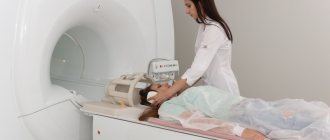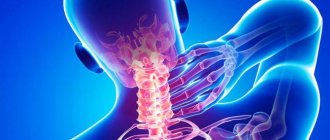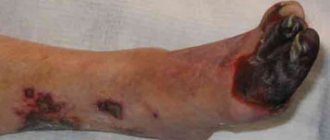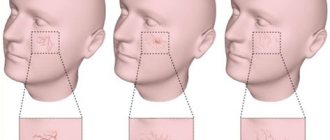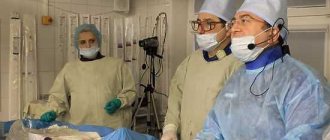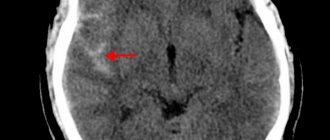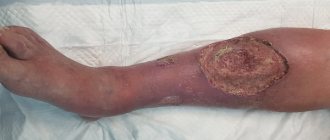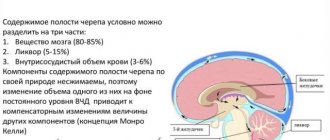The disease belongs to the group of chronic obliterating diseases of the arteries of the legs. This is a whole group of diseases, the common symptom of which is a decrease in blood flow to the limb due to stenosis (narrowing) or occlusion (complete blockage) of the artery. The stage of arterial insufficiency and the degree of tissue ischemia (bleeding) depend on the degree of stenosis. The more pronounced the stenosis, not to mention the occlusion, the less blood volume enters the limb.
Changes in the vascular wall of the arteries, which lead to stenosis or occlusion of the vessel, occur in many diseases, but most often the cause is only four diseases:
Obliterating atherosclerosis - develops mainly in men over 40 years of age against the background of increased cholesterol levels (low and very low density lipoproteins). Mainly large and medium caliber arteries are affected, such as: aortic bifurcation; common iliac; femoral and popliteal arteries.
Obliterating endarteritis (thromboangiitis obliterans, Buerger's disease) is an inflammatory disease of the vascular wall of autoimmune origin, usually occurring at a young age. The disease is characterized by the presence of autoantibodies and circulating immune complexes in the blood. In the initial stages of the disease, mainly small and medium caliber arteries are affected, in particular, the arteries of the leg and foot. At later stages, larger arteries are involved in the pathological process - popliteal, femoral and iliac.
Nonspecific aortoarteritis (Takayasu's disease) is an inflammatory disease of autoimmune origin affecting the aorta and its large branches.
Diabetic angiopathy. Occurs in patients suffering from diabetes. Diabetic angiopathy is characterized by damage to both small and large vessels. Changes in the vascular wall occur especially often in arteries of medium and small caliber (popliteal, tibial, arteries of the foot).
In addition to the above diseases, post-embolic occlusion, traumatic thrombosis, as well as congenital diseases (hypoplasia, aplasia and fibromuscular dysplasia) are much less common.
It is generally accepted among specialists to divide the vascular bed of the lower extremities, including according to the level of disease damage, into 3 levels (segments):
- aorto-iliac;
- femoral-popliteal;
- popliteal tibial (peripheral)
The incidence of obliterating atherosclerosis and other occlusive diseases of the arteries of the lower extremities is not reliably known, since about half of patients with diseases of the peripheral arteries of the lower extremities do not have any symptoms or signs of the disease. However, the incidence of peripheral artery disease of the lower extremities is known to increase with age and at least 25% of the US population suffers from these diseases.
Narrowing of blood vessels in the legs: causes
Stenosis is a pathology of the cardiovascular system, often affecting the vessels of the legs. Narrowing of the arteries of the lower extremities is caused by deposits formed inside the vessel. In the vast majority of clinical cases, deposits are formed due to increased concentrations of lipids in the blood plasma. An excess of these fat-like organic compounds forms fat accumulations on the vascular walls. The most famous lipid is cholesterol. By combining with calcium, which plays a structural role, and connective tissue substances, cholesterol is converted into cholesterol plaques. Therefore, stenosis, despite its local nature, is a manifestation of atherosclerosis.
Narrowing of the blood vessels in the legs also occurs for a number of other reasons, independent of disorders in the body’s fat metabolism. A common cause of stenosis is considered to be genetics. A hereditary feature, namely a predisposition to a particular disease, manifests itself depending on the accumulation of pathological genes. As soon as their interaction with environmental factors of varying strength reaches its maximum, a person notices signs of a disease that was previously diagnosed in his close relatives.
Many other pathological processes and diseases are quite capable of causing narrowing of the arteries of the legs. Among them:
- hypertension (disturbs normal blood circulation);
- thyrotoxicosis and diabetes mellitus of any type (provoke metabolic disorders);
- arteritis, vasculitis and various diseases characterized by inflammation of the arteries of the legs (reduces vascular patency);
- calculous cholecystitis in a complicated form (disturbs the functioning of blood vessels);
- diseases of the hematopoietic system;
- oncology, etc.
!
Narrowing of the arteries of the lower extremities can occur under the influence of harmful addictions.
Smoking and alcohol abuse cause vascular spasms, which prevent the normal movement of blood through them. Alcohol negatively affects red blood cells. Under its influence, their shell is destroyed. Red blood cells stick together, forming clots and leading to partial blockage of the artery. Blood cannot freely penetrate through the remaining lumen of the vessel. An incorrectly organized lifestyle (overeating, lack of exercise, unstable emotional background, etc.) leads to metabolic disorders and poor circulation.
Vessels in the legs are also narrowed due to injuries, hypothermia or overheating of the body. Age-related changes, which reduce the elasticity of the vascular walls, also affect their narrowing. The list of causes that cause stenosis of the vessels of the legs is very wide. Therefore, it is extremely important to know the symptoms of the disease. More on this later in our article.
Narrowing of blood vessels in the legs - symptoms
Narrowing of blood vessels in the legs: symptoms and consequences
Vasoconstriction of the lower extremities has several stages of development. And not all of them have clear symptoms. The first stage can be called asymptomatic. The patient does not notice any changes in his condition or does not attach much importance to them.
Vasoconstriction makes itself felt gradually. As the disease progresses, the nutrition of tissue cells deteriorates due to insufficient blood supply. Some patients begin to notice that their legs feel cold and sensitivity is impaired. And only then do they wonder what is happening to them? This means that the symptom complex of the pathology is increasing. In its manifestations, this is called obliterating atherosclerosis and is characterized by the following unpleasant sensations in the lower extremities:
- a feeling of tingling and burning in the feet;
- pain in the ankle and toes;
- intermittent claudication syndrome;
- increased sweating;
- swelling;
- cyanosis;
- hypertension, etc.
Due to the fact that the disease is detected in late stages, the symptoms are already its consequences. Therefore, along with the above symptoms, patients are faced with:
- necrosis and rotting of soft tissues;
- muscular atrophy of the lower extremities;
- dysfunction of the pelvic organs;
- trophic ulcers.
The above consequences mean that the disease is already severe, and may lead the patient to subsequent disability.
Expert opinion
Not only the localization of pathology in the veins of the lower extremities, but also in the arteries can lead to dangerous consequences for the health and even the life of the patient. In particular, stenosis of cerebral vessels deserves special attention. A gradual decrease in the lumen of the veins and arteries that supply the brain leads to a decrease in the volume of nutrients necessary for the normal functioning of the brain. This leads to the development of neurological problems, the most dangerous of which is stroke.
Vascular surgeon, phlebologist
Osipova Ekaterina Yakovlevna
Statistics on the development of deep vein thrombosis by disease
Treatment
Based on the results of the examination, a treatment regimen adapted to the individual patient is prescribed.
In the early stages of stenosis, drug therapy is prescribed using drugs aimed at restoring and maintaining the elasticity of blood vessels; the patient also takes vasodilators. At the medical center. Rabin uses unique thrombus-dissolving drugs. With a properly designed treatment regimen, it is possible to achieve high treatment efficiency and avoid surgical intervention.
In the case of a critical stage of the disease, an operation is required, the purpose of which is to widen the affected vessel and install a special stent to prevent its re-narrowing.
Depending on the indications, angioplasty or stenting surgery is performed.
Balloon angylplasty
. The angioplasty procedure is an advanced endovascular technology that is performed without tissue incision and does not require intubation anesthesia. Using special miniature instruments with visual X-ray control, a special catheter with an inflatable balloon at the end is inserted into the artery. When a blockage in the vessel is reached, the balloon expands, expanding the lumen of the artery to its normal size. A self-absorbable stent is inserted into the lumen, which then serves as the frame of the vessel, with a special drug coating. When performing cryoplasty, liquid nitrous oxide is introduced into the balloon instead of air, and as a result of exposure to extremely low temperatures, the atherosclerotic plaque is destroyed.
The latest endoscopic equipment used in the medical center named after. Rabin, allows you to achieve the highest precision of all manipulations performed and restore the patency of blood vessels in the lower extremities.
Bypass surgery
. Open surgery is performed when balloon angioplasty is not possible for medical reasons. During surgery, a special shunt is created from a section of the saphenous vein of the leg to bypass the affected vessel. The operation is performed under general anesthesia.
In particularly difficult cases, endovascular (intravascular) balloon angioplasty with stenting and bypass surgery are performed simultaneously.
Narrowing of blood vessels in the legs: how is stenosis diagnosed?
What to do if symptoms of the disease are detected? In order to avoid an unfavorable prognosis due to narrowing of the blood vessels in the legs, you should plan a visit to the doctor as soon as possible. During it, the specialist will:
- a thorough survey to judge the development of a particular disease, its possible causes, and also to preliminarily assess the severity of the patient’s condition;
- examination of the legs to assess the condition of the skin;
- palpation of the extremities for pain, pastiness and compaction along the vessels.
After a physical examination, the doctor prescribes the necessary laboratory diagnostics of the patient’s condition. This may include:
- general clinical tests;
- extended hemostasiogram;
- lipid profile;
- immunogram;
- D-dimer test;
- analysis of blood composition for gases and acidity.
Diagnosis of narrowing of blood vessels in the legs
In turn, instrumental diagnosis of the disease is carried out in various ways: Dopplerography, duplex and triplex scanning, sonography, X-ray contrast angiography, electrocardiography, EchoCG, infrared thermography, rheoencephalography, etc. The most informative methods are considered to be contrast angiography and tomography with contrast. The selection of the optimal diagnostic method or their combination is made by the doctor individually in each specific case.
Symptoms of OASNK
- Pain in the leg at rest, depriving the patient of sleep;
- Pain or a feeling of fatigue in the leg muscles when walking (usually in the calf muscles) - this symptom is one of the early signs of atherosclerosis of the leg vessels;
- Unusual feeling of chilliness and numbness in the foot, aggravated by physical activity (walking, climbing stairs;
- The presence of a non-healing wound or trophic ulcer, usually located in the foot or lower third of the leg;
- Darkening of the skin, often in the form of dark brown or black necrosis of the toes (gangrene);
- Difference in skin temperature between extremities (the affected leg is cooler than the healthy leg).
Stages of development of atherosclerosis of the lower extremities
The manifestation of one or another symptom depends on the stage of atherosclerosis of the arteries of the lower extremities. In this connection, the following stages are distinguished (in our country, classification according to A.V. Pokrovsky, 1976):
- Stage I – pain in the lower extremities manifests itself during heavy physical activity, walking over a distance of more than 1 km.
- Stage II A – pain in the limb occurs when walking at a normal pace for more than 200 m.
- Stage II B - pain in the limb occurs when walking at a normal pace of less than 100-200 m,
- Stage III – pain in the limb occurs at rest or when walking less than 25 m.
- Stage IV – the pain is constant, there are ulcerative-necrotic changes in the tissue.
Most often, the level of damage is accompanied by complaints of characteristic localization.
With atherosclerosis of the aorta and iliac arteries, the so-called Leriche syndrome, in which pain is localized in the gluteal muscles, thigh muscles, there is no pulsation in the femoral arteries, or it is sharply weakened. Men also experience impotence.
With obliterating atherosclerosis of the femoral and popliteal arteries, pain is localized in the muscles of the legs and feet.
Vasoconstriction of the lower extremities: treatment
If, after going through all the stages of the examination, the doctor diagnoses a patient with narrowing of blood vessels in the legs, then the question arises, how and with what to treat it? Treatment methods depend on the causes that caused it, the stage at which vasoconstriction of the lower extremities was detected, and the patient’s concomitant diseases. So, for example, treatment for a patient with diabetes will differ from the therapeutic regimen prescribed for a patient with heart disease. Therefore, the choice of treatment should be made only by a doctor who can take into account all available and possible nuances.
At the moment, patients who are found to have narrowing of the blood vessels in their legs are offered medication, physiotherapy and surgical treatment. In consultation with your doctor, additional treatment with folk remedies is possible.
Let's start with the fact that special importance is given to maintaining a healthy lifestyle and rational food intake.
!
It is important to give up bad habits, get moderate physical activity, have a harmonious daily routine and eat right.
So, to strengthen the walls of blood vessels, you should add nuts, berries, fruits (no more than 2 fruits per day), legumes, cruciferous vegetables, garlic, bone broths, etc. to your diet. If these recommendations are not followed by the patient, then any treatment method will be ineffective .
The drug treatment method primarily involves taking medications that increase elasticity and reduce vascular permeability. Narrowing of the blood vessels in the legs requires combined treatment with medications. Therefore, when considering how to help a patient with pain in the legs, the doctor may prescribe antispasmodics, analgesics and non-steroidal anti-inflammatory drugs. In addition, antiplatelet agents, diuretics, antihypertensive and other drugs are prescribed. With an integrated approach, treatment with folk remedies is acceptable to cleanse the vessels of the lower extremities and reduce the pathological signs of the disease. For these purposes, infusions of peony, motherwort, valerian, rowan, etc. are used.
Treatment of vasoconstriction in the legs
In some cases, physiotherapy methods are used to achieve maximum therapeutic effect. First of all, these are therapeutic exercises and massage, which can be performed even at home. Electrophoresis and laser therapy are also used in hospital settings.
What to do if vasoconstriction in the legs is detected in the later stages? If the disease is detected at stage 2 and beyond, then you will still have to take medications, but surgery cannot be avoided. With stenotic disorders at these stages, the narrowing of the blood vessels in the legs reaches 50% or higher, which can lead to death. Surgical treatment methods include: endarterectomy, bypass surgery, prosthetics, thrombectomy. The result of treatment will be the expansion of the lumen between the walls of blood vessels and improved blood supply to the lower extremities.
Risk factors for OASNK
Atherosclerosis of the vessels of the lower extremities is characterized by the same risk factors as other arterial diseases, for example: coronary heart disease and cerebrovascular insufficiency.
- High blood pressure (hypertension),
- High blood cholesterol levels,
- Smoking,
- Sedentary lifestyle,
- Obesity,
- Burdened heredity.
A few words about smoking. Complete abstinence from any form of tobacco is necessary. Smoking even 1 cigarette per day of the lightest type is an unfavorable risk factor that causes the progression of obliterating atherosclerosis of the lower extremities and the development of its severe complications. The nicotine contained in tobacco causes the arteries to spasm, thereby preventing blood from moving through the vessels and increasing the risk of blood clots in them.
Video: What is vasoconstriction and how to deal with it
is not responsible for the accuracy of the information presented in this video clip. Source - Medservice Izhevsk
Sources:
- Karpenko A.A., Starodubtsev V.B., Ignatenko P.V., Zoloev D.G. Hybrid surgical interventions in patients with multilevel atherosclerotic lesions of the arteries of the lower extremities // Angiology and Vascular Surgery. 2014. T. 20, No. 2.
- Bondarenko M.A., Lebedeva E.A., Artyushin B.S. Biomechanical method for studying the influence of atherosclerotic lesions on hemodynamics in the arteries of the lower extremities // Proceedings of St. Petersburg Electrotechnical University "LETI". 2015. No. 9.
- Begun P.I., Krivokhizhina O.V., Sukhov V.K. Computer modeling and biomechanical analysis of critical condition and correction of structures of the vascular system (Part I) // Management in medicine and biology. 2005. No. 6.
- OBLITERATING ATHEROSCLEROSIS OF THE LOWER LIMB IN ELDERLY PEOPLE. Polyakov P.I., Gorelik S.G., Zheleznova E.A. // Bulletin of new medical technologies. – 2013. – No. 1. – P. 98-101.
- DIAGNOSTICS OF THROMBOTIC PROCESSES IN THE VEINS OF THE LOWER LIMB IN OUTPATIENT PRACTICE. Vlasova I.V., Tleubaeva N.V., Vlasov S.V., Pronskikh I.V. // Polytrauma. – 2011. –№3. – P. 65-75.
- https://iliveok.com/health/disease-peripheral-vessels-legs_112749i16070.html
- https://medlineplus.gov/ency/article/000170.htm
For an accurate diagnosis, contact a specialist.
How is the examination performed?
If you suspect stenosis of the lower extremities in the Israeli clinic named after. Rabin carries out a highly informative examination program, which begins with a thorough study of the course of the disease and the patient’s complaints. Ultrasound classification of stenosis is mandatory.
The patient is prescribed:
- Doppler ultrasound;
- duplex ultrasound scanning;
- computed axial tomography;
- magnetic resonance angiography with the introduction of a contrast agent.
The vascular surgeon measures blood pressure in the shoulder and ankle area, determining the frequency and quality of the pulse. The patient undergoes extended blood biochemistry. If there are concomitant chronic diseases, an examination is performed by related specialists of the medical center.
